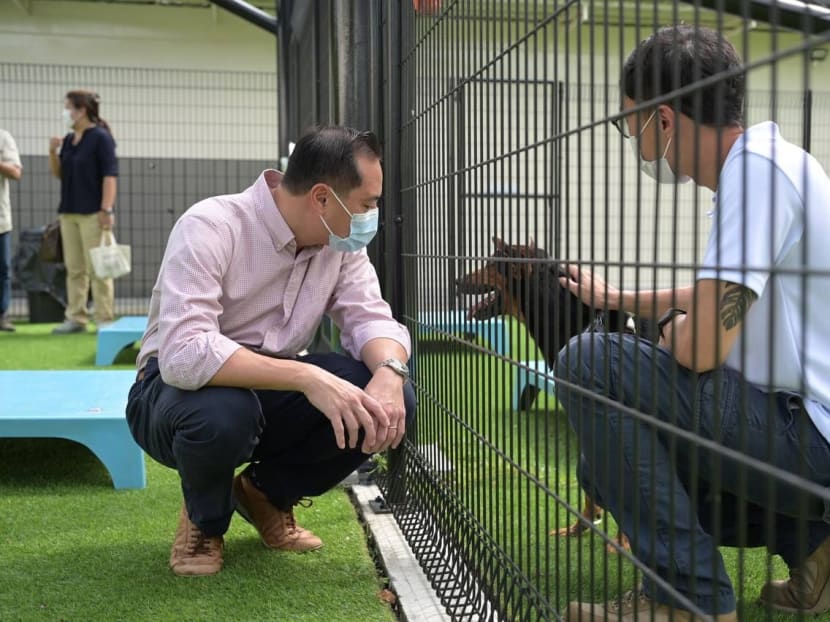Singapore opens first animal rehabilitation centre to help strays adapt to domestic living, find adopters
SINGAPORE — A new animal rehabilitation facility has been opened to take in stray animals and help them adapt tp domestic surroundings, so that they can more easily find adopters and be rehomed.

Mr Tan Kiat How, Minister of State for National Development, at the Centre for Animal Rehabilitation’s dog run.
- The Animal and Veterinary Service has opened the first dedicated centre to help stray animals adapt to domestic life
- The Centre for Animal Rehabilitation is aimed at raising the chances of stray animals being rehomed
- The facility features a visitor centre that mimics a typical home and kennels designed to reduce animals' stress
- It has also started a pilot collaboration with the Society for the Prevention of Cruelty to Animals
SINGAPORE — A new animal rehabilitation facility has been opened to take in stray animals and help them adapt to domestic surroundings, so that they can more easily find adopters and be rehomed.
Located at Lim Chu Kang, the Centre for Animal Rehabilitation is managed by the Animal and Veterinary Service (AVS).
It has 13 kennels to acclimatise stray dogs to a typical home environment and two cat rooms that can house up to 10 cats.
At its official opening on Thursday (March 31), Dr Chang Siow Foong, the group director of AVS, said that the facility has been specially designed to create a conducive environment where the animals can go through a science-based rehabilitation programme.
"Through this programme, they become much better adjusted and adapted, to become more comfortable to stay in a home," he said.
FEAR, ANXIETY AND STRESS
The Centre for Animal Rehabilitation was designed around consultations with Dogs Trust, the largest dog welfare group in Great Britain, and the findings of the AVS' pilot canine rehabilitation programme Project Rehab.
Since November 2019, 70 dogs have been successfully rehabilitated and rehomed by animal welfare groups through Project Rehab.
“We wanted a space that mimics the home environment... (to get) the dogs comfortable with the sounds of the television or vacuum, which are new to them.Dr Chang Siow Foong, the group director of the Animal and Veterinary Service”
Dr Chang said: "Stray dogs come from different environments, so some may not be socialised to human interactions or the urban environment. They may carry a bit of fear, anxiety and stress."
Some key features of the centre include a visitors centre that mimics a home living and dining room, equipped with everyday appliances.
"We wanted a space that mimics the home environment... (to get) the dogs comfortable with the sounds of the television or vacuum, which are new to them."
The dog kennels are also arranged such that dogs do not face other kennels, reducing their stress levels.
Dr Audrey Chen, the director for the Centre of Animal Rehabilitation, said: "The kennels are also compartmentalised into two sections, a sleep area and an active area. Given the choice of where they want to be, we found that it helps reduce their stress levels."
The centre also features two dog runs and a clinical facility.
ASSESSMENTS EVERY THREE MONTHS
Upon arrival, dogs are assessed by AVS veterinarians and are microchipped, vaccinated, neutered and treated if necessary.
They then undergo behavioural observation to determine if rehabilitation is required. If so, AVS spends two weeks identifying problem areas while considering other factors such as the dog's health status and behavioural history.
"We craft bespoke behaviour modification plans for each dog... which is more effective and gives them a chance for rehoming," Dr Chang said.
Every three months, the dogs are assessed until they are deemed ready. Then, animal welfare groups such as the Society for the Prevention of Cruelty to Animals (SPCA) will help find potential adopters.
"Through this programme and facility, we hope to see community animals.... rehomed, adjust well and that adopters are given the right support in terms of caring (for the animal) and continue their rehabilitation if needed," Dr Chang said.
During the centre's opening ceremony, Mr Tan Kiat How, Minister of State for National Development, said that having fewer stray dogs on the streets eases the community's concerns about dog welfare, as well as the potential risks to public safety and health.
"By continually strengthening our community animal management and care capabilities, we can ensure better health and welfare for these animals."
Since the launch of the Trap-Neuter-Release-Manage programme in 2018, public feedback on stray dogs has dropped by more than 60 per cent, he said.
The programme, developed together with animal welfare groups, was launched as a nationwide initiative to provide a humane, scientific and sustainable method of managing the stray dog population here through sterilisation, among other methods.
AVS hopes to sterilise 70 per cent of stray dogs by 2023, with most finding homes after that.
Mr Tan also urged people to adopt instead of buying animals, and to take part in AVS' outreach events to learn more about pets' behavioural needs and best practices.
AVS also launched a pilot programme in collaboration with SPCA to exchange knowledge and improve the transition process between rehabilitation and finding a home for animals.
Ms Aarthi Sankar, executive director of SPCA, said that the facility will make it easier for the animals to be adopted since they are already used to a home environment, which addresses some concerns adopters have.
"Through this collaboration, SPCA staff can also work hand-in-hand with AVS staff to rehome some of these animals and share key information on best practices and rehabilitation," she said.











